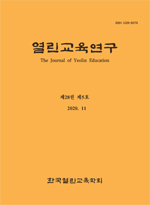이 연구에서는 한국어 교수법을 중심으로 하여 다문화 교육의 일부로서 초등학교에서 이뤄지고 있는 한국어 교육(교수법)의 현황과 과제를 문헌을 통해 탐색했다. 현황과 과제를 구분하여 연구 결과를 정리하면 다음과 같다. 첫째, 교육(교수법) 현황은 다음과 같다. 상향식 교수법이 주를 이루고 있고, 과정중심의 교육이 소홀히 되고 있으며, 통합적인 언어사용을 위한 기능 강화가 미흡하다. 뿐만 아니라 언어 기능을 분리하여 가르치도록 교재가 구성되어 있다. 둘째, 과제는 다음과 같다. 초등 다문화 학생을 위해 한국어 교육을 할 경우에 한국어 교육을 병렬 이중 언어 교육의 차원에서 접근할 필요성이 있고, 상향식 교수법뿐만 아니라 하향식 교수법도 함께(혹은 더 중요하게) 강조해야 한다. 뿐만 아니라 과정 중심의 교육을 강화하고, 따로따로 현상이 아닌 통합적인 언어 사용 능력 신장을 지향해야 하고, 문장 구성 능력을 강화해야 한다.
In this study, we explored the current status and challenges of Korean language education(the teaching method) in elementary schools as part of multi-cultural education, focusing on Korean teaching methods. The results of this study are organized by separating the current status and challenges as follows. First, regarding the current status of education: Bottom up teaching methods are the main focus, course-oriented education is neglected and the enhancement of functions for integrated language use is insufficient. In addition, textbooks are organized to teach language functions separately. Second, the challenges are as follows. In the case of Korean language education for multi-cultural students in elementary schools, educational needs should be approached in terms of coordinated bilingual language education, and top down teaching methods that are emphasized along with bottom up teaching methods as well. In addition, course-oriented education needs to be strengthened, and integrated language skills pursed, and the ability to organize Korean sentences skills likewise strengthened.
Ⅰ. Introduction
Ⅱ. The Current Status of Korean Language Education
Ⅲ. The Challenges of Korean Language Education
Ⅳ. Conclusion
References
